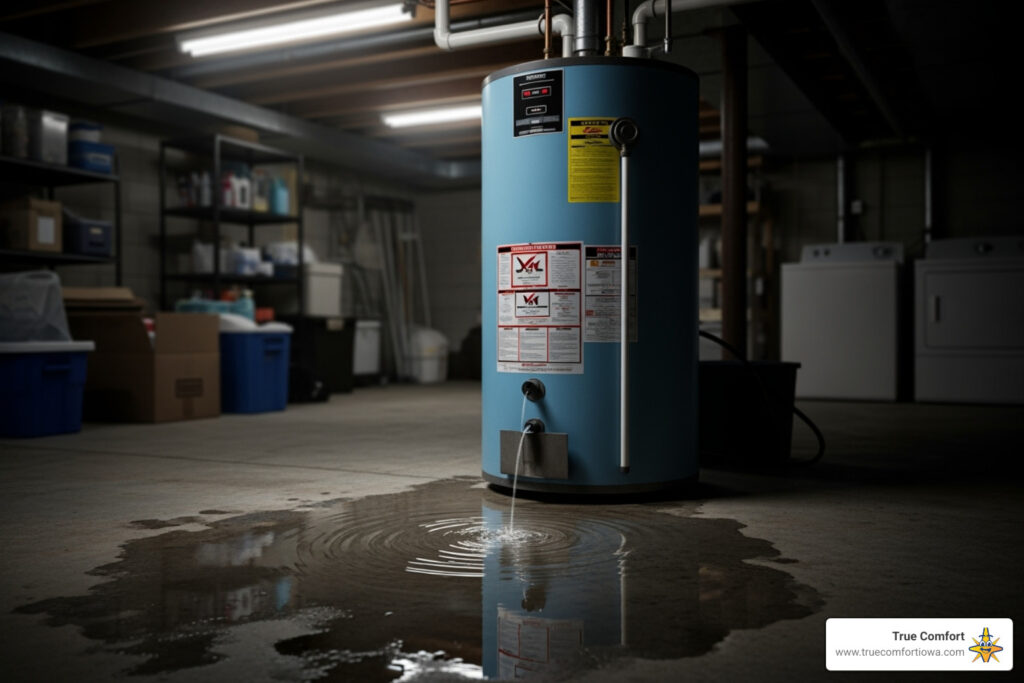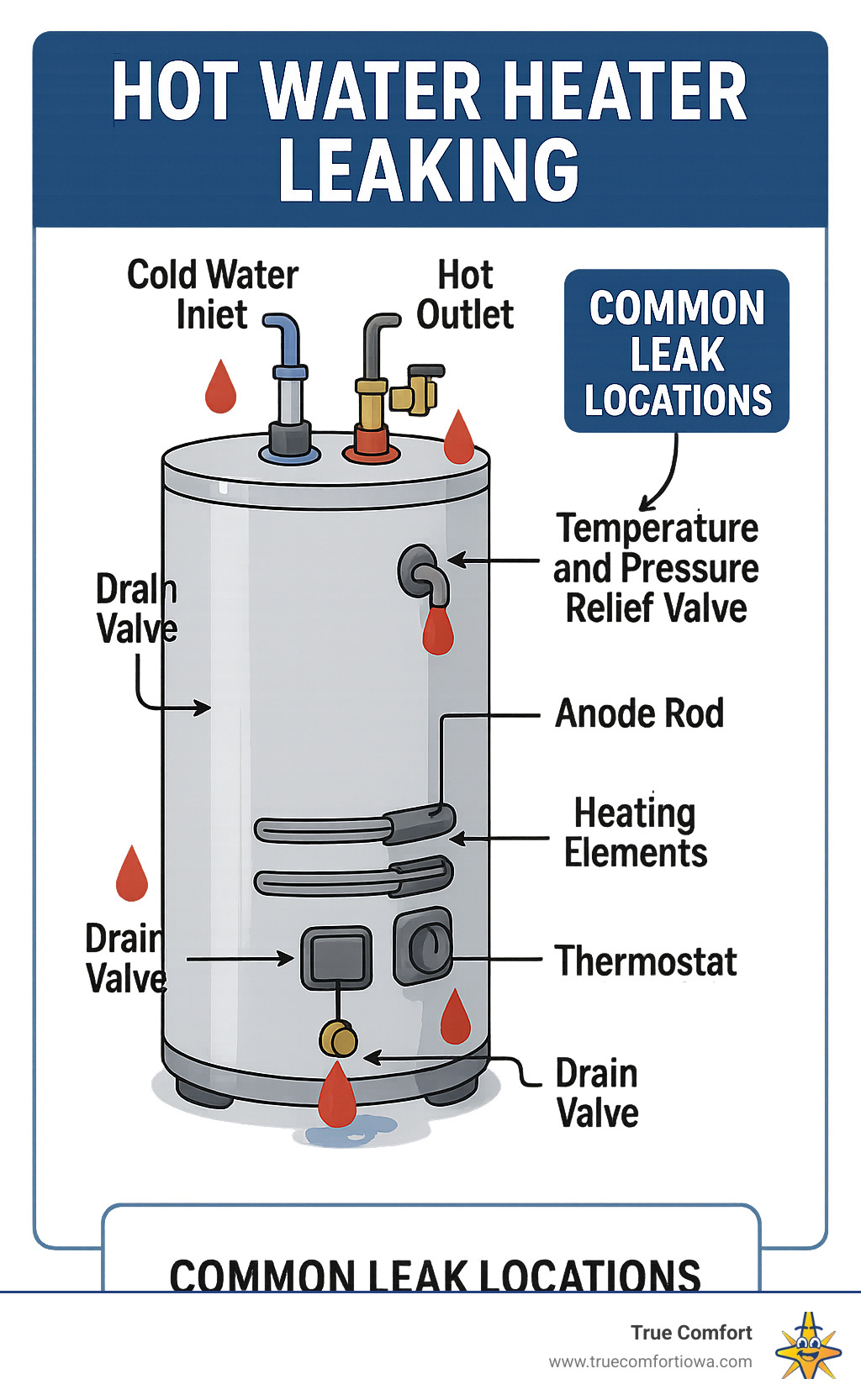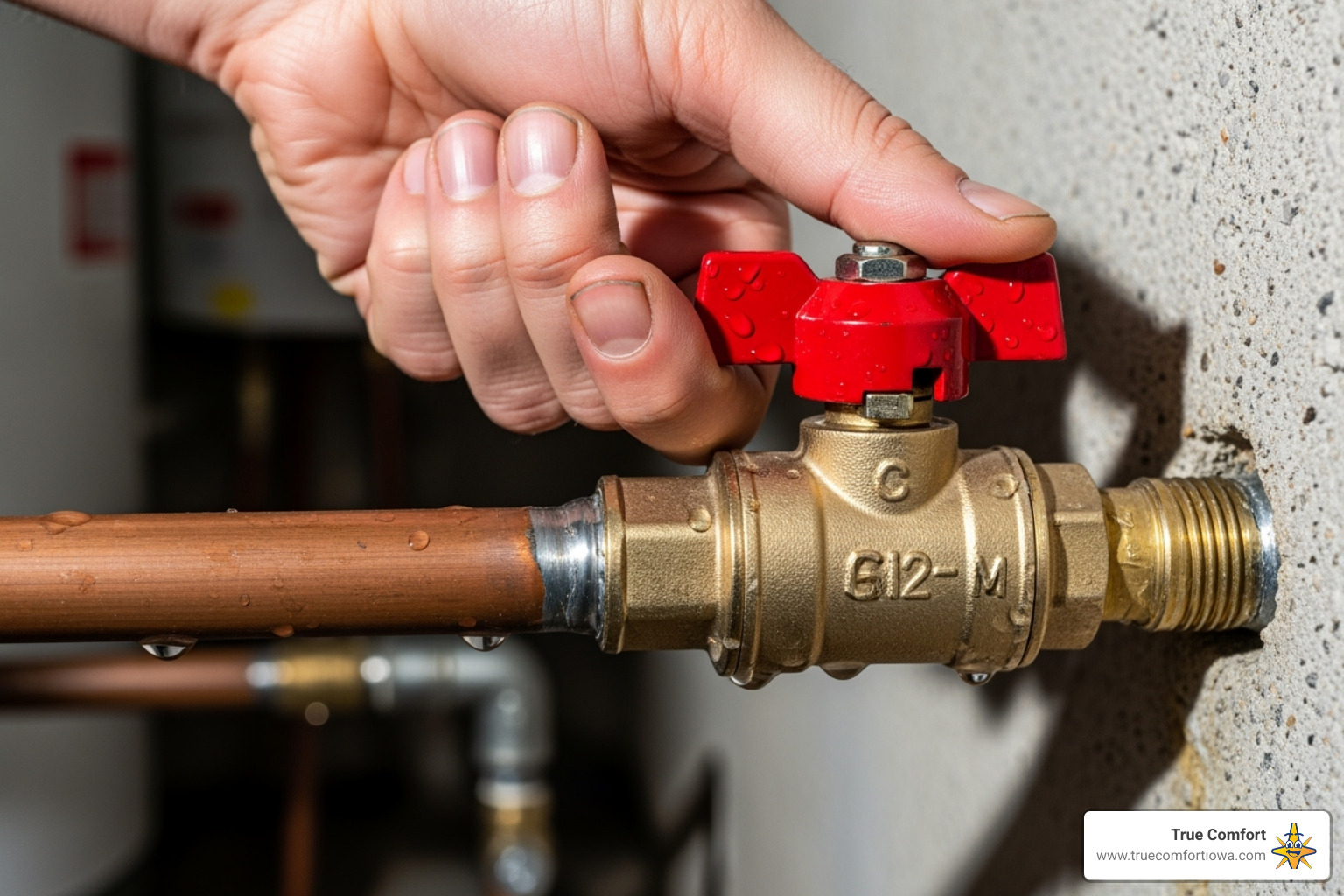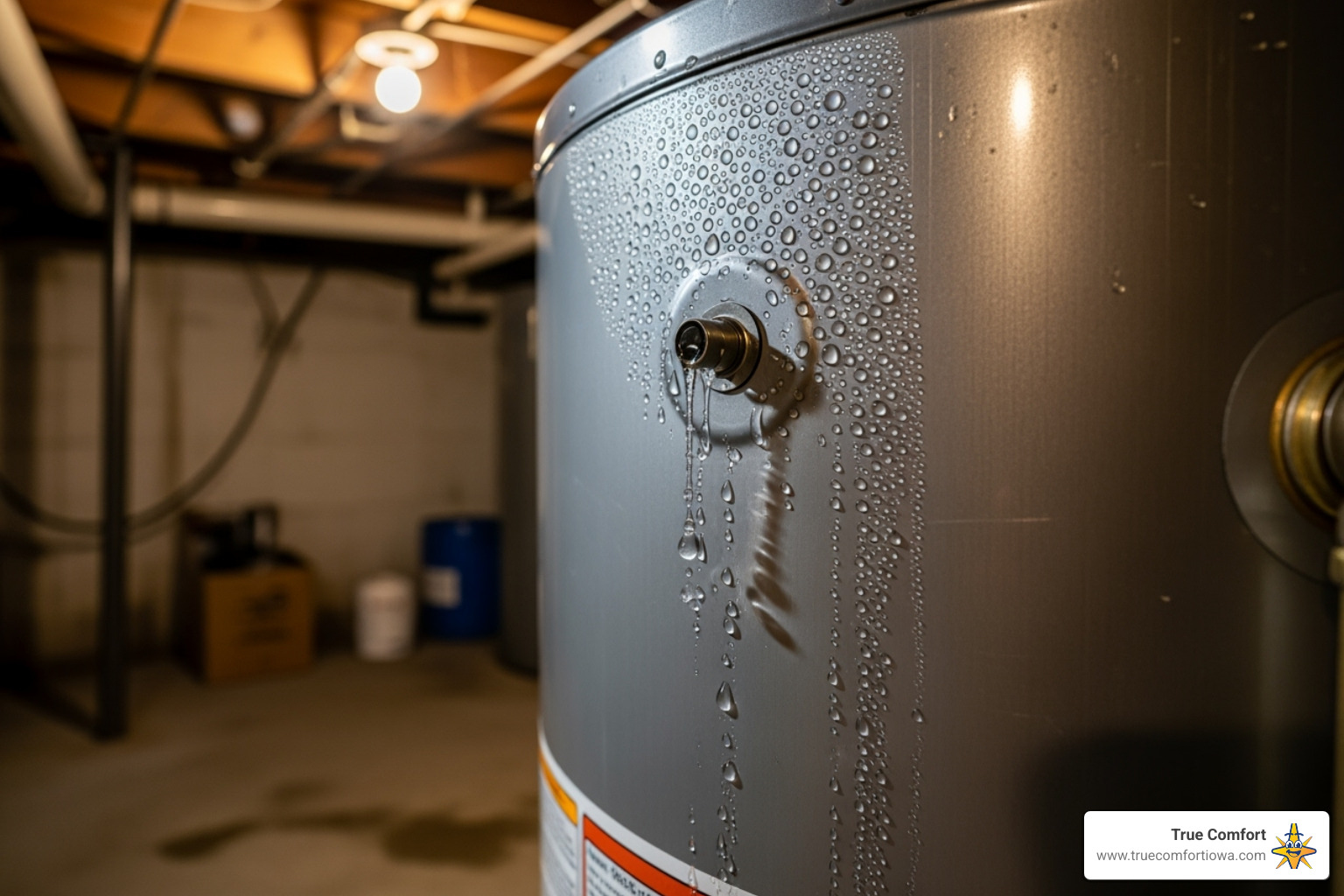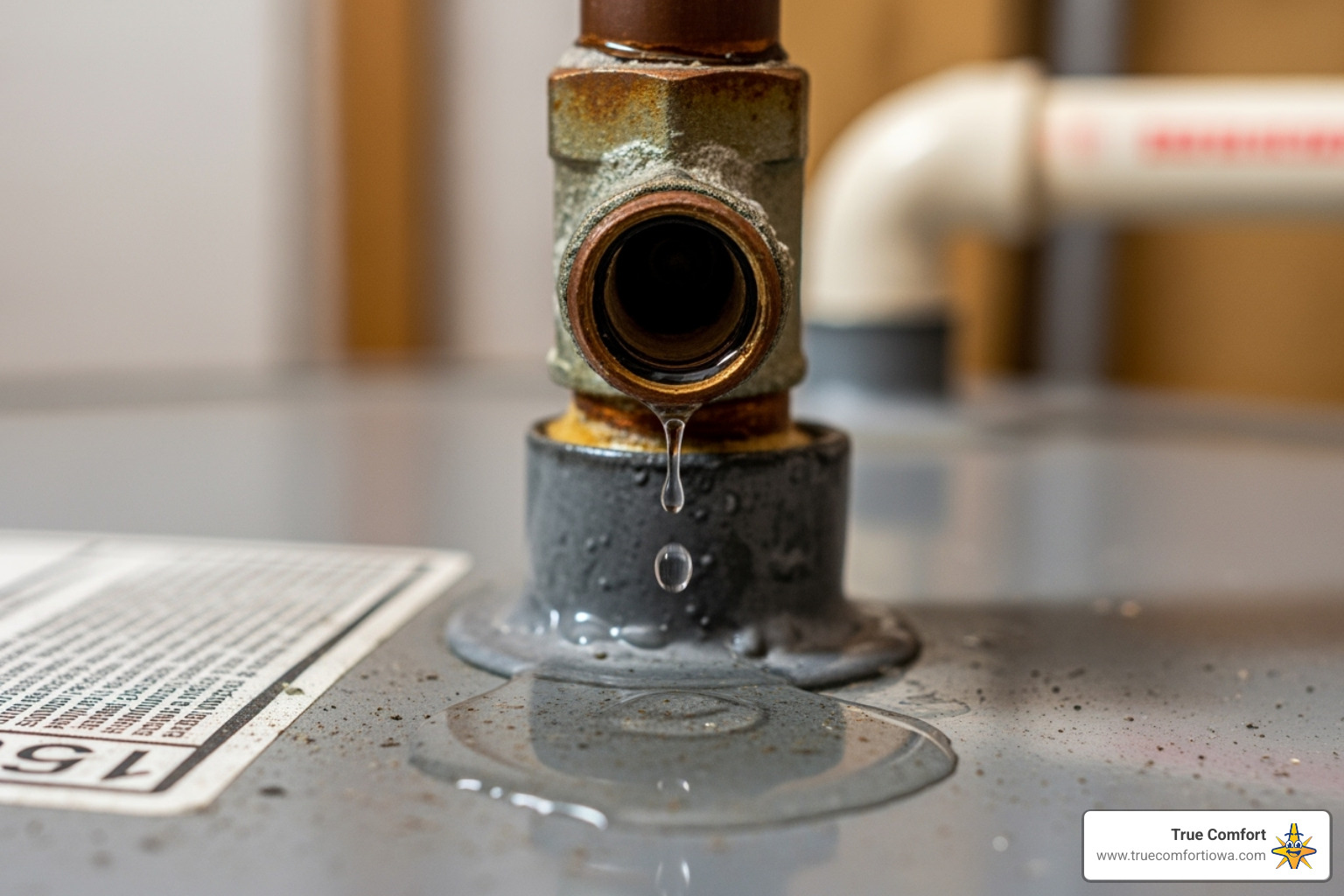When Your Water Heater Springs a Leak: Don’t Panic, Take Action
Finding a hot water heater leaking can send any homeowner into panic mode – and for good reason. That puddle of water around your unit isn’t just an inconvenience; it’s a warning sign that could lead to thousands of dollars in water damage if ignored.
Quick Action Steps for a Leaking Water Heater:
- Turn off the power – Flip the circuit breaker (electric) or gas shut-off valve (gas)
- Shut off water supply – Turn the cold water inlet valve clockwise
- Check if it’s condensation – Wipe dry and observe if moisture returns
- Identify leak location – Top (fittings), side (relief valve), or bottom (tank damage)
- Call a professional – For safety and proper diagnosis
The good news? Not every drop of water means you need a new water heater. Many leaks come from loose fittings or faulty valves that can be repaired. However, some leaks – especially from the bottom of the tank – signal that replacement time has arrived.
Water heaters typically last 8-12 years, so age matters when deciding between repair and replacement. A 10-year-old unit with a major leak often makes more financial sense to replace than fix.
This guide walks you through diagnosing where your leak is coming from and what each location tells you about the severity of the problem. We’ll cover safety steps, troubleshooting methods, and when to call in the professionals.
First Response: What to Do When You Find a Leak
Finding a hot water heater leaking is stressful, but your first priority is safety. Water and electricity are a dangerous mix, and standing water can quickly cause major property damage. Acting fast is key to preventing damage to your flooring, walls, and belongings.
Step 1: Shut Off the Power or Gas Supply
Before you even think about investigating that puddle, you need to cut the power to your water heater. This isn’t optional – it’s a critical safety step that could save your life.
For electric water heaters, head straight to your electrical panel. Look for the breaker labeled “water heater” or “water HTR” – it’s usually a double-wide breaker. Flip it to the OFF position. Don’t worry about being gentle; just get it turned off quickly. This stops the heating elements from running, which eliminates the risk of electrocution.
For gas water heaters, you’ll need to find the gas shut-off valve. It’s typically located on the gas line near the bottom of your unit, or you might see an on/off dial on the water heater itself. Turn the handle or dial clockwise until it stops. If you’re having trouble with a stubborn valve, you can turn the temperature control to “PILOT” as a temporary measure.
If a gas unit continues to heat a leaking tank, it can create dangerous situations like carbon monoxide buildup. Do not skip this step, even if the leak seems small.
Step 2: Turn Off the Water Supply
Now that you’ve eliminated the safety hazards, it’s time to stop more water from making the problem worse. You need to shut off the water flowing into your tank.
Look at the top of your water heater for the cold water inlet valve. This is usually a handle or lever on the pipe bringing water into the tank. Turn it clockwise until it won’t turn anymore. You might encounter either a ball valve (with a lever that turns perpendicular to the pipe when closed) or a gate valve (with a round handle that requires several clockwise turns).
If the valve on your water heater is inaccessible or won’t budge, locate your home’s main water shut-off valve and turn off water to your entire house. This temporary inconvenience is better than a flooded basement.
Knowing your main shut-off’s location is a key homeowner skill that can save you thousands. This guide can help you find and operate your main water valve. Once both steps are complete, the immediate danger is over, and you can assess the situation without the leak getting worse.
If you’re noticing other warning signs beyond just the leak, our guide on Signs You Need Water Heater Repair can help you understand what your water heater might be trying to tell you.
Is It a Real Leak or Just Condensation?
Before you worry about a major repair bill, take a moment to investigate. That puddle around your water heater might not be a leak. Many homeowners find moisture around their unit and assume they have a hot water heater leaking, when it’s actually just harmless condensation.
When cold water enters a tank that’s sitting in a cool, humid basement here in Des Moines, moisture from the air can condense on the cooler surface. This is especially common with electric water heaters during our harsh winters when basement temperatures drop significantly.
Gas water heaters can be trickier to figure out. High-efficiency units with those white PVC vent pipes are actually designed to produce condensate – it’s a normal part of their operation. You might also notice moisture appearing after the burner kicks on following a period of inactivity, or if there’s an issue with the venting system.
Here’s a simple trick we recommend to our customers: grab some paper towels and completely dry off your water heater, paying special attention to any wet spots. Then place fresh, dry towels around the base and on any areas where you noticed moisture.
Wait a few hours and check back. If you see moisture appearing evenly across the tank’s surface – like tiny beads of water or a fine mist – you’re likely looking at condensation. But if water reappears in one specific spot, creates a steady drip, or forms a continuous stream, then you’ve got yourself a genuine leak that needs attention.
Don’t forget to play detective and make sure the moisture isn’t sneaking over from a nearby appliance like your furnace or air conditioner. These systems can also produce condensation that might fool you into thinking your water heater is the culprit. For more insights on unusual water heater behaviors, check out our guide on Fix Whistling Noises in Water Heaters.
Diagnosing Your Hot Water Heater Leaking by Location
Once you’ve confirmed you have a real leak, it’s time to play detective. The location of your hot water heater leaking tells a story about the problem’s severity. A leak at the top usually means something different than a leak at the bottom. Let’s walk through what each location typically means and when it’s time to call the pros. For a broader look at water heater issues, check out our guide on Common Problems Water Heater Repair.
Leaks from the TOP of the Water Heater
Finding water at the top of your water heater is actually good news – relatively speaking. These leaks are usually the most straightforward to diagnose and often the least expensive to fix since they typically involve external connections rather than internal tank problems.
The most common culprit is loose fittings on your cold water inlet or hot water outlet pipes. These are the two pipes at the top that connect your water heater to your home’s plumbing system. Over the years, the constant heating and cooling cycles cause these connections to expand and contract, which can gradually loosen the nuts holding everything together.
You can often spot this by looking for water dripping right where the pipes connect to the tank. If you’re handy with tools, you might try gently tightening these connections with a pipe wrench – but emphasis on gently. Over-tightening can crack the fittings and turn a small problem into a bigger one.
Another possible source is the anode rod connection. This sacrificial metal rod screws into the top of your tank and works behind the scenes to prevent corrosion inside your tank. If the connection point where it enters the tank starts leaking, you’ll typically see water seeping around that area. This repair usually requires professional attention since replacing an anode rod involves specialized tools and knowledge about your specific water heater model. You can learn more about this important component in our Water Heater Anode Rod Replacement guide.
For electric water heaters, heating element gaskets can also be the troublemaker. These gaskets seal where the heating elements enter the tank, and when they wear out, water can leak from those connection points. This repair involves draining the tank and working with electrical components, so it’s typically best left to professionals.
Leaks from the SIDE of the Water Heater
Side leaks often point to your water heater’s safety systems, particularly the temperature and pressure relief valve (T&P valve). This valve is designed to release water if the temperature or pressure inside the tank gets too high.
You’ll usually see the T&P valve on the side of your tank with a discharge pipe running down toward the floor. If water is dripping or flowing from this pipe, don’t ignore it. This could mean two different things, and both need attention.
First, the valve itself might be failing. Like any mechanical part, T&P valves can wear out, develop weak springs, or get corroded over time. When this happens, they’ll leak even when your water heater is operating normally.
The second possibility is more concerning – your T&P valve might actually be doing its job by releasing water because of high pressure or high temperature in your tank. According to the Department of Energy, a leaking T&P valve can indicate excessive pressure in your system. This could point to problems with your thermostat, your home’s water pressure, or the need for a thermal expansion tank.
Never, and we mean never, try to cap off or plug that discharge pipe. That T&P valve is a critical safety feature that prevents your water heater from becoming a very dangerous pressure bomb. If you’re experiencing frequent T&P valve activation, it’s worth having a professional check your water pressure and temperature settings. For more detailed information about pressure issues, see our article on Water Heater Pressure Problems in Des Moines.
Leaks from the BOTTOM of a Hot Water Heater Leaking
Here’s where things get serious. A hot water heater leaking from the bottom is often the most concerning type of leak because it frequently signals that your water heater’s days are numbered.
The first place to check is the drain valve at the very bottom of your tank. This valve is used for maintenance tasks like flushing out sediment. Sometimes these valves don’t close completely or develop leaks over time. If you can see water dripping directly from this valve, try gently tightening it. If that doesn’t work, sediment might be preventing it from sealing properly, or the valve itself might need replacement.
But if you’ve ruled out the drain valve and water is still pooling at the base of your water heater, you’re likely dealing with internal tank failure. This is the water heater equivalent of a terminal diagnosis.
Inside your water heater, there’s a glass lining that protects the steel tank from corrosion. Over time, especially in areas like Des Moines where we deal with hard water, this lining can crack. Once that happens, the steel underneath starts to rust and corrode. Sediment buildup at the bottom of the tank makes this process worse by creating hot spots that weaken the tank’s integrity.
When the internal tank starts failing, water begins seeping through the bottom or side seams. Unfortunately, a cracked or rusted tank cannot be fixed. The entire water heater needs to be replaced.
This might sound scary, but most water heaters last 8-12 years, so if yours is approaching that age range, it’s lived a good life. Ignoring a bottom leak will only lead to more water damage and potentially catastrophic failure down the road.
To better understand how sediment contributes to tank failure, check out our guide on Signs Sediment Buildup in Water Heater. And when you’re ready to explore replacement options, our article Why a Water Heater Replacement? can help you understand your next steps.
Proactive Maintenance to Prevent Future Leaks
Preventative maintenance is the best defense against a hot water heater leaking emergency. Regular service is your best defense against unexpected leaks and can help your water heater reach or even exceed its typical 8-12 year lifespan.
With a little annual attention, your water heater will keep delivering hot showers and clean dishes for years to come.
In areas like Des Moines where hard water is common, maintenance becomes even more critical. Those minerals that make our water “hard” are constantly working against your water heater, building up sediment and accelerating corrosion. The good news? A few simple maintenance tasks can keep these problems at bay.
The Role of Regular Maintenance
Annual flushing is perhaps the most important thing you can do for your water heater. All that sediment from hard water doesn’t just disappear – it settles at the bottom of your tank like sand at the beach. Over time, this buildup creates hot spots that can weaken your tank and lead to cracks. Flushing removes these deposits before they cause damage. Our Water Heater Flush Service takes care of this messy job so you don’t have to.
Your anode rod is like a bodyguard for your water heater tank. This sacrificial piece of metal attracts all the corrosive elements in your water, protecting the steel tank from rust. But like any good bodyguard, it eventually wears out after 3-5 years of faithful service. In homes with water softeners or very hard water, anode rods can deplete even faster. Regular inspection and replacement keeps your tank’s protection intact.
Don’t forget about T&P valve testing either. This safety valve is your water heater’s pressure release valve, and it needs an annual check to make sure it’s working properly. A gentle lift and release of the lever should show you if it’s functioning correctly. If it doesn’t snap back or starts dripping afterward, it’s time for a replacement.
If your home has a closed plumbing system, a thermal expansion tank helps absorb the pressure created when water heats up and expands. Without one, this pressure can stress your water heater and cause premature failure of seals and valves.
When to Repair vs. When to Replace
Sometimes despite your best maintenance efforts, your water heater will develop problems. The big question then becomes: fix it or replace it?
Age matters most in this decision. If your water heater is over 10 years old and developing issues, replacement often makes more financial sense than repair. Think of it like an old car that needs constant fixes – at some point, you’re throwing good money after bad.
The extent of the problem also guides your decision. Minor issues like loose fittings or a faulty T&P valve? Those are usually worth fixing. But if you’re dealing with a cracked tank or internal rust, there’s no repair option – replacement is your only choice.
Energy efficiency is another factor many homeowners overlook. Today’s water heaters are significantly more efficient than models from even 10 years ago. The energy savings from a new unit can help offset the replacement cost over time, especially if your current unit is an energy hog.
For Des Moines area homeowners wrestling with this decision, we’re here to help. Our guide on Choosing a Water Heater for Des Moines Home can walk you through your options. And when you’re ready to move forward, we can help you Schedule Water Heater Replacement at your convenience.
Frequently Asked Questions about a Hot Water Heater Leaking
When you find a hot water heater leaking, it’s natural to have questions racing through your mind. As HVAC professionals serving Des Moines and surrounding communities, we hear the same concerns from homeowners time and again. Let’s address the most pressing questions to help you understand what you’re dealing with.
What are the consequences of ignoring a leaking water heater?
Ignoring a hot water heater leaking will only make the problem worse, and the consequences can be both costly and dangerous.
Water damage is your most immediate concern. A puddle can quickly turn into a homeowner’s nightmare as water seeps into subflooring, drywall, insulation, and even the structural elements of your home.
Mold and mildew growth follows close behind. Des Moines basements are already prone to humidity issues, and a leaking water heater creates the perfect breeding ground for these unwelcome guests. Not only do they create musty odors that permeate your home, but they can also pose serious health risks to your family.
Your utility bills will climb as your water heater struggles to do its job efficiently. A leaking unit often signals internal problems like sediment buildup or failing components. This forces your water heater to work overtime, burning through energy and driving up your monthly costs. If you’re hearing unusual sounds along with the leak, like popping noises, check out our guide on Water Heater Makes Popping Sounds to understand what’s happening inside your tank.
The most frightening scenario is catastrophic tank failure. What starts as a small drip can escalate to a complete tank rupture, releasing 40-80 gallons of hot water in minutes. Imagine coming home to find your basement flooded with scalding water – it’s not just property damage you’re looking at, but potential injury to anyone who encounters that flood.
How long do most water heaters last?
Understanding the typical lifespan of your water heater helps you make informed decisions about repair versus replacement.
Most conventional tank water heaters last 8-12 years with proper care. However, this isn’t a hard rule – we’ve seen units fail at 6 years and others soldier on for 15 years or more. The difference usually comes down to maintenance, water quality, and installation quality.
Tankless water heaters have a significant advantage here, often lasting 20 years or more. Without a storage tank constantly exposed to corrosive water, they face fewer of the internal challenges that plague traditional units.
Regular maintenance makes all the difference. Annual flushing, anode rod inspections, and professional tune-ups can add years to your water heater’s life. Conversely, neglecting maintenance – especially in hard water areas like much of Iowa – can cut that lifespan in half.
Hard water is particularly tough on water heaters. The mineral deposits that build up inside your tank create hot spots, accelerate corrosion, and force your unit to work harder. If you’ve noticed white, chalky buildup on your faucets, your water heater is fighting the same battle internally.
For specific insights about water heater longevity in our area, our article on How Long Water Heaters Last in Des Moines covers the local factors that affect lifespan.
Is a leaking water heater an emergency?
This is probably the question we get asked most often, and the honest answer is: it depends on what’s leaking and how fast.
A minor drip from a loose connection at the top of your unit isn’t going to flood your house overnight, but it still needs prompt attention. Think of it as urgent rather than emergency-level. You have time to call a professional during normal business hours, but don’t put it off for weeks.
A leaking T&P relief valve is absolutely an emergency. This safety device only activates when pressure or temperature inside your tank reaches dangerous levels. If water is flowing from the discharge pipe, your water heater is essentially screaming for help. Turn off the power and water supply immediately, then call for professional service. Never ignore this or attempt to cap off the valve – it’s there to prevent your water heater from becoming a bomb.
Bottom tank leaks are serious emergencies. When water seeps from the base of your tank, it almost always means the internal tank has cracked or corroded through. This type of leak can escalate rapidly from a few drops to a major flood. We’ve responded to calls where homeowners went to work with a small puddle and came home to inches of water covering their basement floor.
Any significant or rapidly growing leak should be treated as an emergency. If you’re mopping up water faster than you can keep up with it, or if shutting off the water supply doesn’t stop the leak, don’t wait – get professional help immediately.
When you’re unsure about the severity, it’s always better to be safe than sorry. A quick professional assessment can save you thousands in water damage repairs and give you peace of mind.
Your Next Steps for a Leak-Free Home
Finding a hot water heater leaking doesn’t have to ruin your day. By now, you’ve learned the essential safety steps, how to distinguish a leak from condensation, and how to play detective to figure out where the water is coming from.
The location of your leak tells quite a story. A drip from the top usually means loose fittings or connections that can often be tightened up. A leak from the side might point to your T&P relief valve doing its safety job (though it needs attention). But when water pools at the bottom, especially from the tank itself, it’s usually time to start shopping for a replacement.
Regular maintenance really is your best friend when it comes to preventing these watery surprises. Annual flushing, checking that anode rod, and testing your T&P valve can add years to your water heater’s life. Think of it as a small investment that prevents big headaches down the road.
Here’s the thing about water heater repairs: some are perfect weekend DIY projects, while others require professional expertise. Tightening a loose pipe fitting? Go for it. Dealing with a faulty T&P valve or replacing heating elements? That’s when it makes sense to call in the pros for both safety and peace of mind.
At True Comfort, we’ve helped countless homeowners across Des Moines, Ankeny, Clive, and throughout Polk County tackle their hot water heater leaking challenges. Our certified technicians don’t just fix the immediate problem – we’ll give you an honest assessment of your entire system and help you understand whether repair or replacement makes the most sense for your situation.
Whether you’re dealing with an active leak right now or you’re thinking it might be time for some preventive maintenance, we’re here to help. No surprise fees, no pressure tactics – just straight talk about what your water heater needs to keep your family comfortable.

